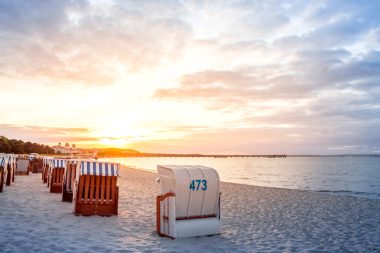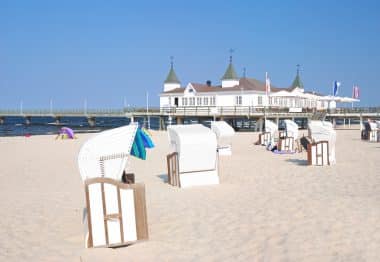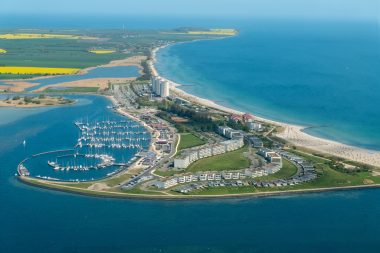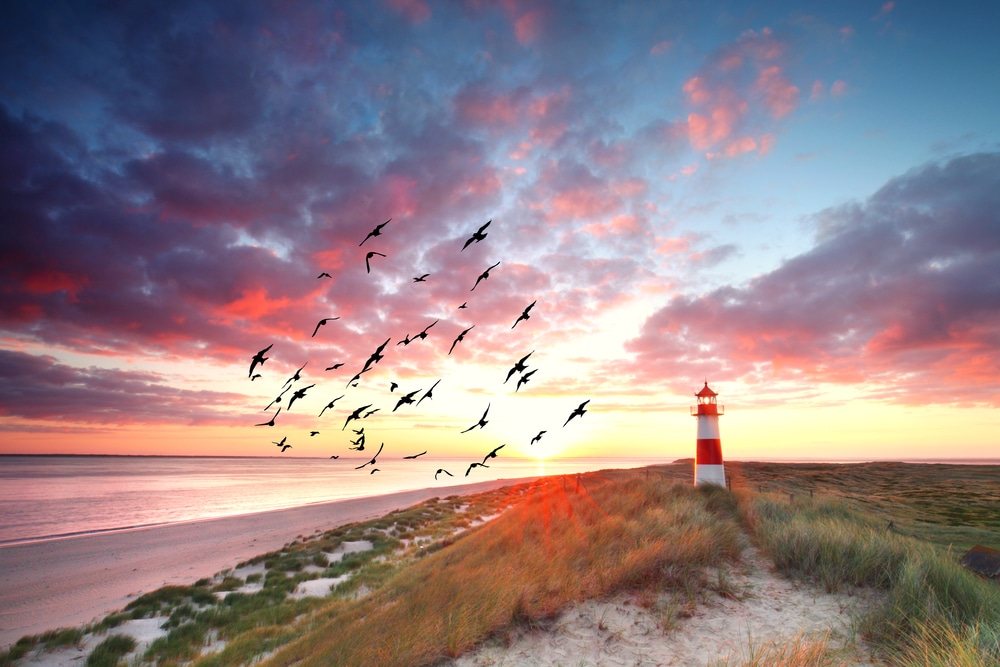In addition to a number of small inland islands in rivers or lakes, such as the Lake Constance island of Mainau or the Weser island of Harriersand, Germany can boast more than three dozen sea islands in the North Sea and Baltic Sea. With the exception of the rocky island of Heligoland, which is about one square kilometre in size, all German North Sea and Baltic Sea islands are located less than 20 km from the coasts of Schleswig-Holstein, Lower Saxony and Mecklenburg-Western Pomerania. The larger of these islands in particular are extremely popular tourist destinations. Many guests rent holiday apartments on the Baltic Sea or North Sea and thus have the flexibility to explore the islands independently. Here is some brief information about the “Big Four” of these islands:
Rügen – Western Pomerania’s land in the sea

With an area of over 900 square kilometres, Rügen , which is rich in bays and peninsulas, hills, chalk cliffs and forests, is the largest German island by area. Rügen can also claim the insular German record in terms of population: More than 60,000 people have their primary residence on the island, which belongs to the Vorpommern-Rügen district. The central towns are the island’s capital Bergen (13,000 inhabitants), the port and seaside resort of Sassnitz (9,000 inhabitants) as well as Binz (5,000), Putbus (4,500) and Garz (2,500). And Rügen, which is economically oriented towards tourism, can claim another superlative for itself: With an average of five to six million overnight stays per year, Rügen is the record holder among the German holiday islands.
Rügen is geographically separated from the mainland with the Hanseatic city of Stralsund by the Strelasund branch of the Baltic Sea, which is up to two kilometres wide. This inlet can be crossed via the imposing, almost 3000-metre-long, multi-lane Rügen Bridge, which was opened to car traffic in 2007. Until then, the Rügen Dam, which opened in 1936 and continues to be used, was the only main connection across the Strelasund. The Rügendamm bascule bridge (113 metres long), which serves both car, pedestrian and rail traffic, connects the small island of Dänholm, which belongs to Stralsund, with Rügen. Dänholm, in turn, is connected to the mainland by the Ziegelgraben Bridge. The two fixed Strelasund crossings will be supplemented by a regular ferry service.
Rügen’s culture and landscape have a lot to offer its numerous guests. More than 50 kilometres of sandy beaches and seaside resorts such as Sellin, Putbus and Binz invite you to enjoy the water and walk in the white spa architecture typical of Rügen. History buffs will get their money’s worth in the Granitz hunting lodge (19th century) or in the holiday apartment complex “Koloss von Prora” (1930s), which is reminiscent of Rügen’s history as a KdF seaside resort.
Usedom – two-state island in the Baltic Sea

In the far east of the Mecklenburg-Western Pomerania coast near the Polish city of Szcesin (Szczecin) lies the 445 square kilometer island of Usedom. Usedom is separated from the mainland by the narrow Peene River. A 225-metre-long bascule bridge connects Usedom with the mainland near Wolgast. A special feature of the island in the Pomeranian Bight, which is considered the “Sun Island”, is its historically determined division into a German part (373 square kilometres) and a Polish part (72 square kilometres). With about 32,000 people, almost half of the island’s population lives in the German part. Before Corona, over 1.2 million tourists visited the island, each booking an average of five nights. Particularly attractive for spa tourism are the more than 40-kilometre-long sandy beach and the largest European beach promenade with a length of almost 13 kilometres, which leads from the German imperial spa of Ahlbeck to the Polish port city of Świnoujście. Typical for Usedom are also the piers that protrude up to 500 meters into the sea, an emphasis on the wellness aspect in hotels and spa facilities as well as numerous nature reserves. The most important German towns on the island are Heringsdorf (8,900 inhabitants), Zinnowitz (4,000 inhabitants) and the small town of Usedom (1,700 inhabitants), the only German island town with town rights.
Fehmarn – Schleswig-Holstein’s largest island

Fehmarn (14,000 inhabitants) is located one kilometre off the coast of East Holstein. In terms of landscape, the 186 square kilometre island is mainly characterised by pastures, dune landscapes and cliff coast sections as well as sandy beaches. Since 1963, the Fehmarn Sound, which separates the island and mainland, has been crossed by a road and railway bridge (“Fehmarnsund Bridge”). Ferries run regularly from the island port of Puttgarden to neighbouring Denmark. In addition to agriculture and wind energy, Fehmarn’s economy is based in particular on tourism. Like Usedom, Fehmarn is also called “Sun Island”. Politically, Fehmarn forms a single urban municipality. The largest district of the city is the Heilbad Burg (6000 inhabitants).
Sylt – North Frisia’s main island
In the north of the North Frisian Wadden Sea, the almost 100 square kilometre Sylt stretches over 40 kilometres off the west coasts of Schleswig-Holstein and Denmark. In addition to ferries and small aircraft, Sylt can be reached by rail via an eleven-kilometre-long track embankment (“Hindenburgdamm”). Motor vehicles can only reach the island on car trains or ferries. Typical for Sylt is the sandy beach on the west side in front of a cliff coast. Wide dune landscapes also invite you to relax. On the island, which is sometimes called the “island of the rich and beautiful” or “jet-set island” because of its above-average proportion of extremely wealthy, often prominent tourists and foreign second home owners, there is a wide range of gastronomic delicacies, entertainment options and health-promoting measures. Most of the approximately 18,000 islanders are at home in the municipality of Sylt, which was created in 2007 by the merger of the city of Westerland with the neighboring towns of Sylt-Ost and Rantum. In addition, there are the villages of List (northernmost municipality in Germany), Kampen, Hörnum and Wenningstedt.
Insular diversity – the next largest islands
In the size ranking, the “Big Four” of the German islands are followed by Sylt’s sister islands Föhr (83 sq km, 8,500 inhabitants) and Pellworm (37 sq km, 1,200 inhabitants). This is closely followed by Poel (36 sq km, 2,500 inhabitants) near Wismar. The group of East Frisian Islands belonging to Lower Saxony includes Borkum (31 sq km, 5,000 inhabitants) and Norderney (26 sq km, 6,000 inhabitants).


